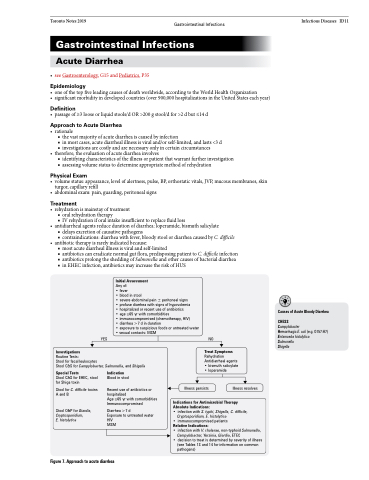Page 611 - TNFlipTest
P. 611
Toronto Notes 2019 Gastrointestinal Infections Infectious Diseases ID11 Gastrointestinal Infections
Acute Diarrhea
• seeGastroenterology,G15andPediatrics,P35
Epidemiology
• oneofthetopfiveleadingcausesofdeathworldwide,accordingtotheWorldHealthOrganization
• significantmorbidityindevelopedcountries(over900,000hospitalizationsintheUnitedStateseachyear)
Definition
• passageof≥3looseorliquidstools/dOR>200gstool/dfor>2dbut≤14d
Approach to Acute Diarrhea
• rationale
■ the vast majority of acute diarrhea is caused by infection
■ in most cases, acute diarrheal illness is viral and/or self-limited, and lasts <3 d ■ investigations are costly and are necessary only in certain circumstances
• therefore,theevaluationofacutediarrheainvolves
■ identifying characteristics of the illness or patient that warrant further investigation ■ assessing volume status to determine appropriate method of rehydration
Physical Exam
• volumestatus:appearance,levelofalertness,pulse,BP,orthostaticvitals,JVP,mucousmembranes,skin turgor, capillary refill
• abdominalexam:pain,guarding,peritonealsigns
Treatment
• rehydrationismainstayoftreatment
■ oral rehydration therapy
■ IV rehydration if oral intake insufficient to replace fluid loss
• antidiarrhealagentsreducedurationofdiarrhea:loperamide,bismuthsalicylate
■ delays excretion of causative pathogens
■ contraindications: diarrhea with fever, bloody stool or diarrhea caused by C. difficile
• antibiotictherapyisrarelyindicatedbecause:
■ most acute diarrheal illness is viral and self-limited
■ antibiotics can eradicate normal gut flora, predisposing patient to C. difficile infection ■ antibiotics prolong the shedding of Salmonella and other causes of bacterial diarrhea ■ in EHEC infection, antibiotics may increase the risk of HUS
Initial Assessment
Any of:
• fever
• blood in stool
• severe abdominal pain ± peritoneal signs
• profuse diarrhea with signs of hypovolemia
• hospitalized or recent use of antibiotics
• age ≥65 yr with comorbidities
• immunocompromised (chemotherapy, HIV)
• diarrhea >7 d in duration
• exposure to suspicious foods or untreated water • sexual contacts: MSM
Causes of Acute Bloody Diarrhea
CHESS
Campylobacter
Hemorrhagic E. coli (e.g. O157:H7) Entamoeba histolytica
Salmonella
Shigella
Investigations
Routine Tests:
Stool for fecal leukocytes
Stool C&S for Campylobacter, Salmonella, and Shigella
Special Tests
Stool C&S for EHEC, stool for Shiga toxin
Stool for C. difficile toxins A and B
Stool O&P for Giardia, Cryptosporidium,
E. histolytica
Indication
Blood in stool
Recent use of antibiotics or hospitalized
Age ≥65 yr with comorbidities Immunocompromised
Diarrhea >7 d
Exposure to untreated water HIV
MSM
Illness persists
Illness resolves
YES
NO
Treat Symptoms
Rehydration Antidiarrheal agents • bismuth salicylate • loperamide
Indications for Antimicrobial Therapy Absolute Indications:
• infection with S. typhi, Shigella, C. difficile,
Cryptosporidium, E. histolytica
• immunocompromised patients
Relative Indications:
• infection with V. cholerae, non-typhoid Salmonella, Campylobacter, Yersinia, Giardia, ETEC
• decision to treat is determined by severity of illness (see Tables 13 and 14 for information on common pathogens)
Figure 7. Approach to acute diarrhea


